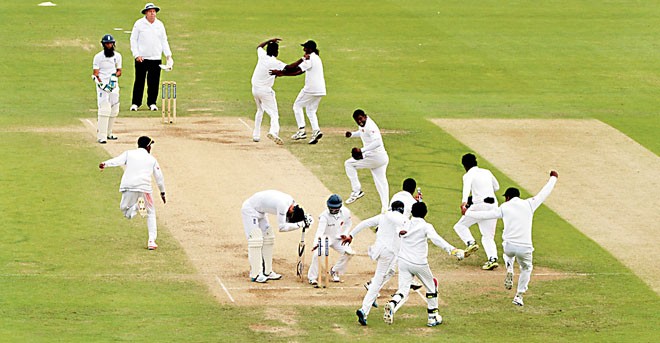

Test cricket is the real cricket. Other formats are just for entertainment. Who says Test cricket is boring and its era is over? The recently concluded England-Sri Lanka Test series was the perfect example of it. Both Tests had nail-biting finishes.
Sri Lanka beat England in the second Test at Headingley by 100 runs on the fifth ball of the last over of the final day. They took the two-match series 1-0. It was only the third occasion when Sri Lanka won a Test on English soil. Previously they had won at The Oval in 1998 and Trent Bridge in 2006.
The first Test at Lord’s had also had a tense finish. Sri Lanka No 11 Nuwan Pradeep had managed to survive the last five balls of the Test, but at Headingly James Anderson, after a heroic effort, failed to save the game.
It was the second consecutive Test series defeat for England following their 5-0 Ashes whitewash in Australia.
At the end of the fourth day of the second Test, England were 57-5 while chasing 350.
Only the most ardent English fans would have given England a chance to save the match. But the tail-enders provided some resistance and took the game into the last session. There were more than 20 overs remaining when Anderson came into bat.
He survived 55 balls without opening his account but the fifth ball of the last over of the match, he gloved paceman Shaminda Eranga to Rangana Herath at leg gully.
Anderson’s 84-minute, 55-ball duck was the second-longest in Test history. New Zealand’s Geoff Allott made a 101-minute, 77-ball nought against South Africa at Auckland in 1999.
Moeen Ali, playing his only the second Test, showed tremendous temperament, scoring 108 off 281 balls in six hours.
Moeen consumed time and almost saved the hosts, but Anderson’s wicket on the second last ball of the series meant it went in vain.
Sri Lanka, with this win, have now won seven Tests outside the subcontinent; three wins have come in England, two in New Zealand and one each in South Africa and West Indies. These seven wins have come in 57 Tests, which makes their win percentage 12.3 percent.
India and Pakistan, the other Subcontinent giants, have win percentages of 12.4 percent (22 wins in 177 Tests) and 21.4 percent (31 wins in 145 Tests), respectively, outside the Subcontinent.
Sri Lanka’s performance in this series was largely due to veteran Kumar Sangakkara, who scored 342 runs in the two Tests, and became the first Sri Lankan batsman to score 300-plus Test in England.
His senior partner Mahela Jayawardene contributed 174 runs. Jayawardene and Sangakkara have now scored 11493 runs each and are joint sixth on the all-time list of highest run-scorers in Tests.
Sangakkara came into this series on the back of three consecutive 50-plus scores against Bangladesh. That sequence has now been extended to seven consecutive fifties. Sangakkara’s batting average of 90.50 since the start of 2013 is the highest for any batsman in this period.
He has scored 1448 runs in 17 innings, which is second only to David Warner who has scored 1484 runs.
Jayawardene took two catches in this match and thus went past Ricky Ponting on the all-time list of outfield players who have taken the most catches in Test cricket. Jayawardene has now taken 197 catches in Test cricket. Ponting had taken 196. Only Rahul Dravid (210) and Jacques Kallis (200) are ahead of him now, both of whom have retired.
Sangakkara was the highest run-getter of the series with 342 runs, including one hundred and three fifties, scored at an average of 85.50.
For England Joe Root scored 259 runs with the help of a double hundred, averaging 86.33. Anderson was the most successful bowler with 12 wickets with the average of 21.50. Shaminda Eranga took 11 wickets at an average of 32.45.